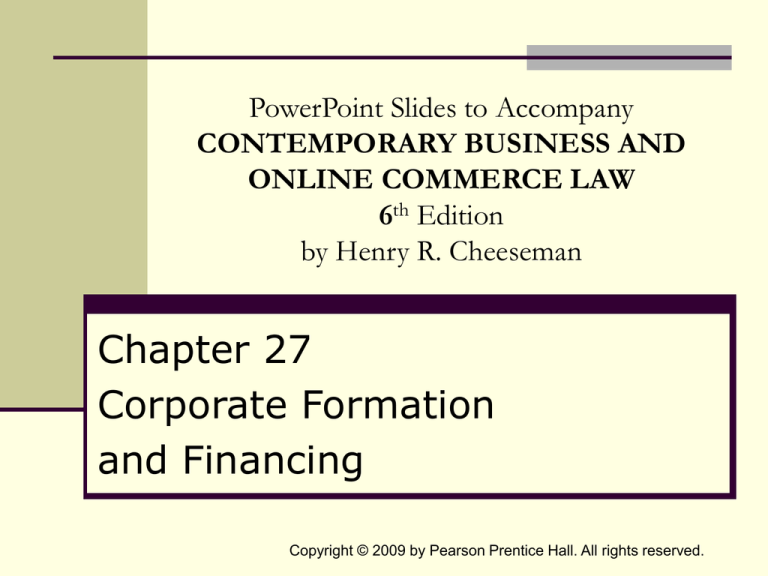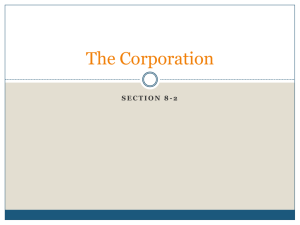
PowerPoint Slides to Accompany
CONTEMPORARY BUSINESS AND
ONLINE COMMERCE LAW
6th Edition
by Henry R. Cheeseman
Chapter 27
Corporate Formation
and Financing
Copyright © 2009 by Pearson Prentice Hall. All rights reserved.
Corporation
A fictitious legal entity that is
created according to statutory
requirements.
Copyright © 2009 by Pearson Prentice Hall. All rights reserved.
27 - 2
Nature of the Corporation
Corporations can only be created
pursuant to the laws of the state of
incorporation.
Corporations Codes – State statutes that
regulate the formation, operation, and
dissolution of corporations.
The courts interpret state corporation
statutes to decide individual corporate and
shareholder disputes.
Copyright © 2009 by Pearson Prentice Hall. All rights reserved.
27 - 3
The Corporation as a Legal “Person”
A corporation is a separate legal entity (or
legal person.)
Corporations are treated as artificial
persons created by the state that can:
Sue or be sued in their own names
Enter into and enforce contracts
Hold title to and transfer property
Be found civilly and criminally liable for violations of law
Copyright © 2009 by Pearson Prentice Hall. All rights reserved.
27 - 4
Characteristics of Corporations
1. Limited Liability
of Shareholders
2. Free Transferability
of Shares
3. Perpetual
Existence
4. Centralized
Management
Copyright © 2009 by Pearson Prentice Hall. All rights reserved.
27 - 5
Corporation
Corporation
Debt or
obligation owed
Third Party
Capital investment
Shareholder
Shareholder
Shareholder
Shareholder
Liability limited to
capital contribution
No personal liability for company’s
debts and obligations
Copyright © 2009 by Pearson Prentice Hall. All rights reserved.
27 - 6
Revised Model Business Corporation
Act (RMBCA)
Model Business Corporation Act (MBCA)
Model act drafted in 1950
Was intended to provide a uniform law for
regulation of corporations
Revised Model Business Corporation Act
(RMBCA)
1984 revision of the MBCA
Many states have adopted all or part of the
RMBCA
Copyright © 2009 by Pearson Prentice Hall. All rights reserved.
27 - 7
There is no general federal corporations
law governing the formation and
operation of private corporations.
Many federal laws regulate the operation
of private corporations.
Copyright © 2009 by Pearson Prentice Hall. All rights reserved.
27 - 8
Classifications of Corporations (1 of
3)
Profit Corporation
A corporation created to conduct a business
for profit
Can distribute profits to shareholders in the
form of dividends
Nonprofit Corporation
A corporation that is formed to operate
charitable institutions, colleges, universities,
and other not-for-profit entities
Copyright © 2009 by Pearson Prentice Hall. All rights reserved.
27 - 9
Classifications of Corporations (2 of
3)
Public Corporation
A corporation formed to meet a specific
governmental or political purpose
Private Corporation
A corporation formed to conduct privately
owned business
Professional Corporation
A corporation formed by lawyers, doctors, or
other professionals
Copyright © 2009 by Pearson Prentice Hall. All rights reserved.
27 - 10
Classifications of Corporations (3 of
3)
Publicly Held Corporation
A corporation that has many shareholders
It’s securities are often traded on national
stock exchanges
Closely Held Corporation
A corporation owned by one or a few
shareholders
Copyright © 2009 by Pearson Prentice Hall. All rights reserved.
27 - 11
Promoters’ Liability (1 of 2)
Promoters often enter into contracts on
behalf of the corporation prior to its actual
incorporation.
If the corporation never comes into
existence, the promoters have joint
personal liability on the contract unless
the third party specifically exempts them
from such liability.
Copyright © 2009 by Pearson Prentice Hall. All rights reserved.
27 - 12
Promoters’ Liability (2 of 2)
If the corporation is formed, it becomes
liable on a promoter’s contract only if it
agrees to to become bound to the
contract.
The promoter remains liable on the
contract unless the parties enter into a
novation.
Copyright © 2009 by Pearson Prentice Hall. All rights reserved.
27 - 13
Incorporation
Corporations are creatures of statute.
The organizers of the corporation must
comply with the state’s incorporation
statute to form a corporation.
A corporation can be incorporated in only
one state even though it can do business
in all other states in which it qualifies to do
business.
Copyright © 2009 by Pearson Prentice Hall. All rights reserved.
27 - 14
Incorporation Procedures (1 of 5)
Incorporator – the person or persons,
partnerships, or corporations that are
responsible for incorporation of a
corporation.
Articles of incorporation – the basic
governing documents of the corporation.
Must be filed with the secretary of state of the state of
incorporation
Can be amended to contain any provision that could
have been lawfully included in the original document
Copyright © 2009 by Pearson Prentice Hall. All rights reserved.
27 - 15
Incorporation Procedures (2 of 5)
Selecting a corporate name – organizers
must ensure that the name is not already
in use and available.
General-purpose clause – a clause often
included in the articles of incorporation
that authorizes the corporation to engage
in any activity permitted corporations by
law.
Copyright © 2009 by Pearson Prentice Hall. All rights reserved.
27 - 16
Incorporation Procedures (3 of 5)
Registered agent – a person or
corporation that is empowered to accept
service of process on behalf of the
corporation.
Corporate bylaws – a detailed set of rules
adopted by the board of directors after the
corporation is incorporated.
Contains provisions for managing the business and the
affairs of the corporation
Copyright © 2009 by Pearson Prentice Hall. All rights reserved.
27 - 17
Incorporation Procedures (4 of 5)
Organizational meeting – a meeting that
must be held by the initial directors of the
corporation after the articles of
incorporation are filed.
Corporate seal – a design containing the
name of the corporation and the date of
incorporation
It is imprinted by the corporate secretary using a metal
stamp on certain legal documents
Copyright © 2009 by Pearson Prentice Hall. All rights reserved.
27 - 18
Incorporation Procedures (5 of 5)
Corporate status – the RMBCA provides
that corporate existence begins when the
articles of incorporation are filed:
The filing of the articles of incorporation is conclusive
proof that a corporation exists
After that, only the state can challenge the status of the
corporation
Third parties cannot thereafter challenge the existence
of the corporation
Copyright © 2009 by Pearson Prentice Hall. All rights reserved.
27 - 19
Types of Corporations
Type of
Corporation
Domestic
Description
Foreign
A corporation is a foreign corporation in states
other than the one in which it is incorporated.
Alien
A corporation is an alien corporation in the United
States if it is incorporated in another country.
A corporation is a domestic corporation in the
state in which it is incorporated.
Copyright © 2009 by Pearson Prentice Hall. All rights reserved.
27 - 20
S Corporations (1 of 2)
Corporations are separate legal entities.
They generally must pay corporate
income taxes to federal and state
governments.
If a corporation distributes its profits to
shareholders in the form of dividends,
shareholders must pay personal income
tax on the dividends.
This double taxation of corporations is a
disadvantage of doing business.
Copyright © 2009 by Pearson Prentice Hall. All rights reserved.
27 - 21
S Corporations (2 of 2)
Some corporations and their shareholders
can avoid double taxation by electing to
be an S Corporation.
If a corporation elects to be taxed as an S
Corporation, it pays no federal income tax
at the corporate level.
The corporation’s income or loss flows to
the shareholders’ individual income tax
returns.
Election is made by filing IRS Form 2553.
Copyright © 2009 by Pearson Prentice Hall. All rights reserved.
27 - 22
Financing the Corporation
A corporation needs to finance the
operation of its business:
Equity securities (or stocks) – represent
ownership rights in the corporation.
Debt securities – establish a debtor-creditor
relationship in which the corporation borrows
money from the investor to whom the debt
security is issued.
Copyright © 2009 by Pearson Prentice Hall. All rights reserved.
27 - 23
Common Stock
A type of equity security that represents
the residual value of the corporation:
Common stock has no preferences
Common stock does not have a fixed
maturity date
Corporations may issue different classes of
common stock
Common shareholders have limited liability
Copyright © 2009 by Pearson Prentice Hall. All rights reserved.
27 - 24
Preferred Stock
A type of equity security that is given
certain preferences and rights over
common stock:
Preferred stock can be issued in classes or
series
One class of preferred stock can be given
preferences over another class of preferred
stock
Preferred shareholders have limited liability
Copyright © 2009 by Pearson Prentice Hall. All rights reserved.
27 - 25
Preferred Stock: Preferences and
Rights
1. Dividend
Preference
3. Cumulative
Dividend Right
2. Liquidation
Preference
4. Right to
Participate in
Profits
Copyright © 2009 by Pearson Prentice Hall. All rights reserved.
5. Conversion
Right
27 - 26
Types of Shares
Type of Share
Description
Authorized
Shares authorized in the corporation’s articles of
incorporation.
Issued
Shares sold by the corporation.
Treasury
Shares repurchased by the corporation. They do not have
the right to vote.
Outstanding
Shares of stock that are in shareholder hands. These
shares have the right to vote.
Copyright © 2009 by Pearson Prentice Hall. All rights reserved.
27 - 27
Debt Securities
Debenture – a long-term unsecured debt
instrument that is based on the
corporation’s general credit standing.
Bond – a long-term debt security that is
secured by some form of collateral.
Note – a debt security with a maturity of
five years or less.
Copyright © 2009 by Pearson Prentice Hall. All rights reserved.
27 - 28
Express Powers of a Corporation
(1 of 2)
A corporation has the same basic rights to
perform acts and enter into contracts as a
physical person.
A corporation’s express powers are found
in:
(1) the U.S. Constitution, (2) state constitutions, (3)
federal statutes, (4) state statutes, (5) articles of
incorporation, (6) bylaws, and (7) resolutions of the
board of directors
Copyright © 2009 by Pearson Prentice Hall. All rights reserved.
27 - 29
Express Powers of a Corporation
(2 of 2)
Generally, a corporation has the power to:
Purchase, own, lease, sell, mortgage, or otherwise deal
in real and personal property
Make contracts
Lend and borrow money
Incur liabilities
Issue notes, bonds, and other obligations
Invest and reinvest funds
Sue and be sued in its corporate name
Copyright © 2009 by Pearson Prentice Hall. All rights reserved.
27 - 30
Implied Powers of a Corporation
Powers beyond express powers that allow
a corporation to accomplish its corporate
purpose:
i.e., a corporation has the implied power to
open a bank account
i.e., a corporation has the implied power to to
reimburse its employees for expenses
Copyright © 2009 by Pearson Prentice Hall. All rights reserved.
27 - 31
Ultra Vires Act
An act by a corporation that is beyond its
express or implied powers
Shareholders can sue for an injunction to
prevent the corporation from engaging in
the act.
The corporation can sue the officers or
directors who caused the act for
damages.
The attorney general of the state of
incorporation can sue to enjoin the act.
Copyright © 2009 by Pearson Prentice Hall. All rights reserved.
27 - 32
Dissolution and Termination
of Corporations
The methods for dissolving and
terminating corporations include:
Voluntary dissolution
Administrative dissolution
Judicial dissolution
Copyright © 2009 by Pearson Prentice Hall. All rights reserved.
27 - 33
Winding-up and Liquidation
The process by which a dissolved
corporation’s assets are collected,
liquidated, and distributed to:
Creditors
Shareholders
Other claimants
Copyright © 2009 by Pearson Prentice Hall. All rights reserved.
27 - 34
Termination
The ending of a corporation that occurs
only after the:
Winding-up of the corporation’s affairs
Liquidation of its assets
Distribution of the proceeds to the claimants
Copyright © 2009 by Pearson Prentice Hall. All rights reserved.
27 - 35


